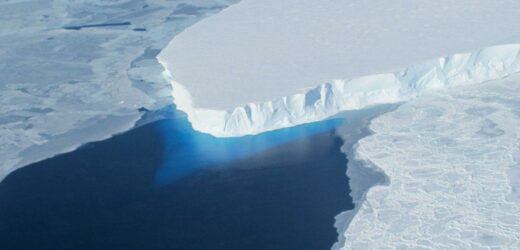Professor explains exactly what the Thwaites Glacier is
We use your sign-up to provide content in ways you’ve consented to and to improve our understanding of you. This may include adverts from us and 3rd parties based on our understanding. You can unsubscribe at any time. More info
The melting could contribute more than 11 feet to global sea level rise over the coming centuries, the study warned. Two huge masses of ice cover Antarctica and feed its many glaciers — the East and West Antarctic Ice Sheets. Thanks to global warming, recent decades have seen an acceleration in the rate at which the western ice sheet has been thinning. In particular, the West Antarctic Ice Sheet’s Pine Island and Thwaites glaciers are particularly vulnerable to global warming, and are already contributing to rising global sea levels.
In a new study, earth scientist Dr Dylan Rood of Imperial College London and his colleagues calculated the rate of local sea level change around these two glaciers.
Such measurements, they explained, serve as an indirect way to measure ice loss.
They found that present rates of glacial retreat are unprecedented in the last 5,500 years.
Both glaciers have the potential to cause large global sea level rises, with the Thwaites glacier alone being nearly the same size as Great Britain, covering a total area of some 74,132 square miles.
The Pine Island glacier, meanwhile, is not much smaller, spanning some 62,664 square miles.


Dr Rood said: “Although these vulnerable glaciers were relatively stable during the past few millennia, their current rate of retreat is accelerating and already raising global sea level.
“These currently elevated rates of ice melting may signal that those vital arteries from the heart of the West Antarctic Ice Sheet have been ruptured.”
This, he explained, would lead “to accelerating flow into the ocean that is potentially disastrous for future global sea level in a warming world.
“We now urgently need to work out if it’s too late to stop the bleeding.”


In their study, the team considered the size of the glaciers going back to the mid-Holocene period — more than 5,000 years ago — during which the climate was warmer than today and thus glaciers were smaller and sea levels were consequently higher.
They focussed on the remnants of old Antarctic beaches, the traces of which today can be found elevated above the modern sea level.
When heavy glaciers form on land, their sheer weight pushes down — or ‘loads’ — the Earth’s surface. Similarly, when they melt, the land rebounds, moving what was once a beach to a position higher than sea level.
In this way, local sea level in Antarctica could fall during the mid-Holocene, even as the melting glacial ice caused the average global sea level to rise.
By determining the age of the various ancient beaches — achieved by radiocarbon dating of seashells and penguin bones — the team were able to reconstruct the past changes in Antarctica’s relative sea level over time.
DON’T MISS:
Putin humiliated as Israel turns on ‘ally’ Russia to strike EU deal [ANALYSIS]
Macron warned of horror ‘nuclear accident’ at EDF’s plants [INSIGHT]
Germany sends warning to Putin in ‘territorial command’ launch [REPORT]

Lead author and geologist Professor Brenda Hall of the University of Maine said: “Relative sea-level change allows you to see large-scale crustal loading and unloading by ice.
“For example, glacier re-advance, which would result in crustal loading, would slow the rate of relative sea-level fall or potentially even cause submergence of the land below sea level.”
The team’s results indicated a steady fall in relative sea level over the last 5,500 years — a finding which the team interpret as being the result of ice loss just prior to that period.
This behaviour, they explained, is consistent with relatively stable glacier behaviour.
However, the researchers also found that the rate of relative sea-level fall since the mid-Holocene is almost five times smaller than that measured today — a difference attributable to rapid recent ice losses.
Future research, the team said, will see rock samples collected from underneath the glaciers to help determine if the current accelerating melting rates might still be reversible.
The full findings of the study were published in the journal Nature Geoscience.
Source: Read Full Article


